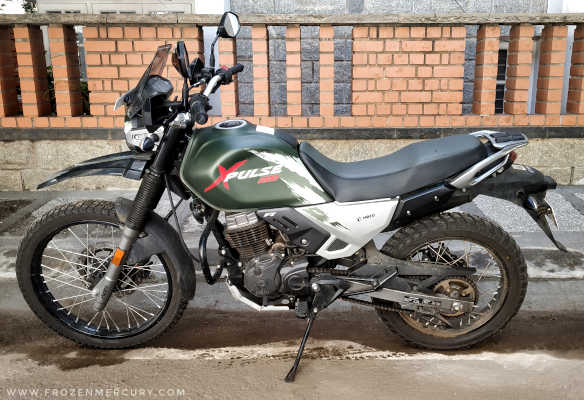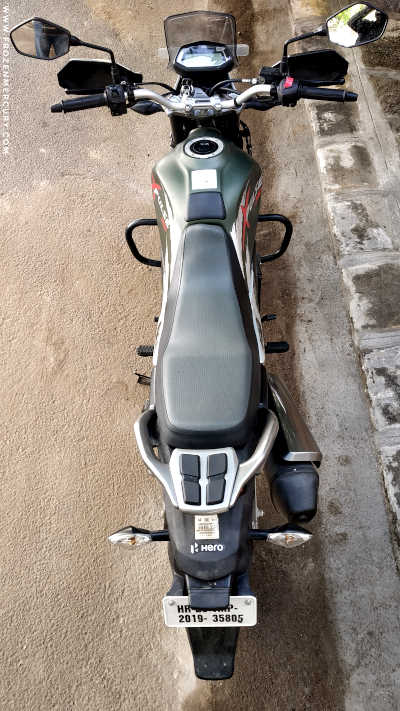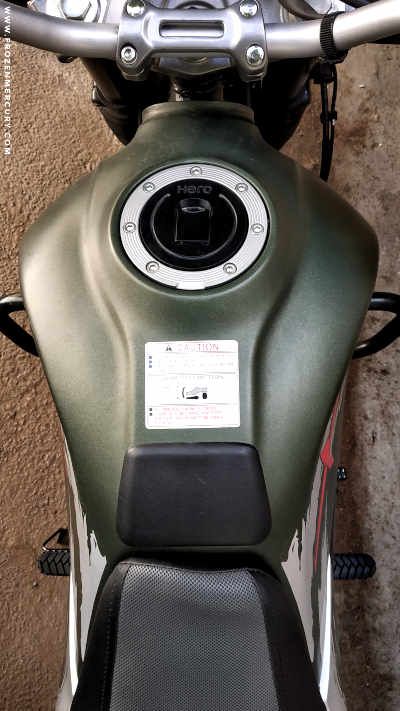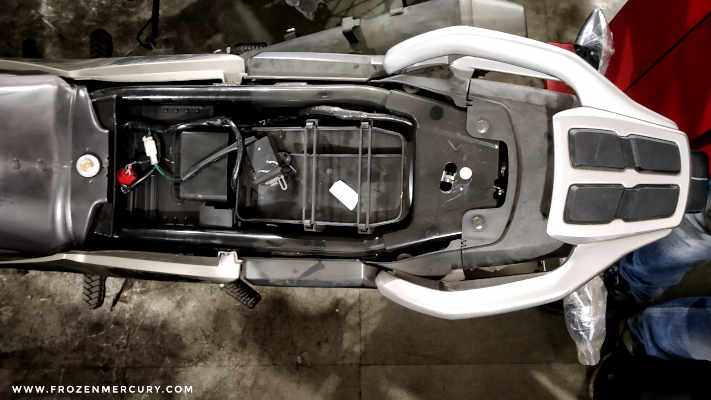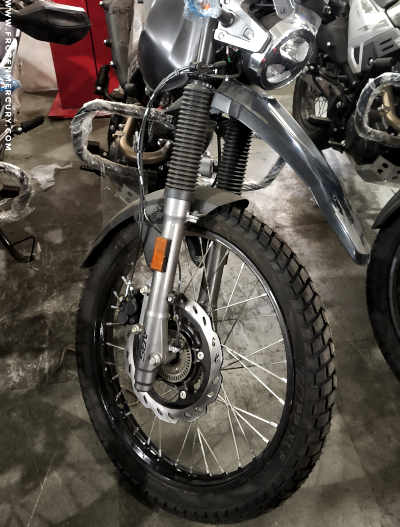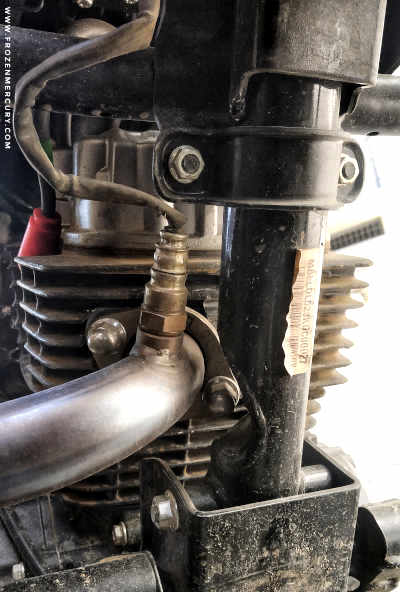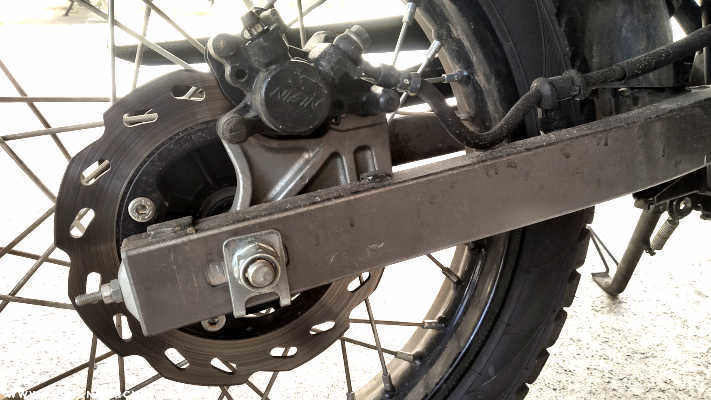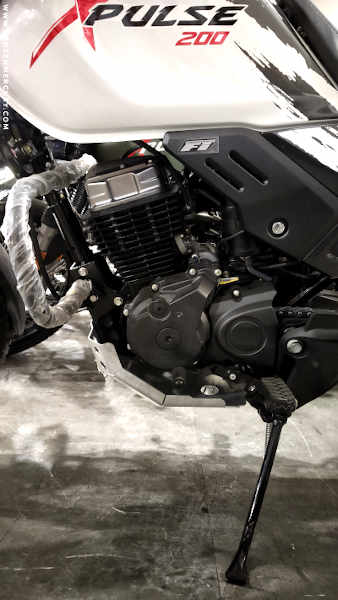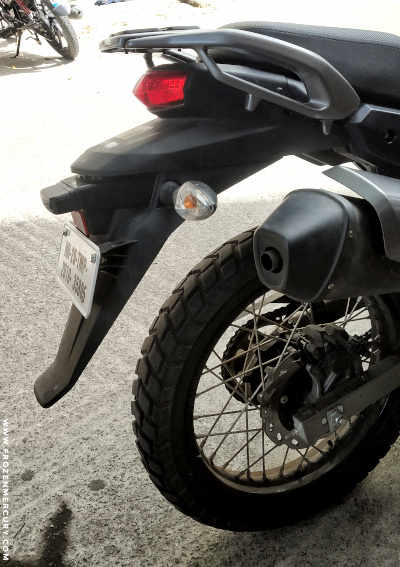
An affordable entry level motorbike that has qualities of a good commuter with descent off-roading capabilities. What it has to offer with the relevant five 'W's answered.
From Hero MotoCorp’s current offering (i.e., Xpulse 200, Xpulse 200T, Xtreme 200S and Xtreme 200R), the Xpulse 200T, 200S and 200R are carburetted, while the Xpulse 200 is the only one that comes with the option of either carburetted or fuel-injected to choose from. The carburetted variant is for ₹ 97,000 (ex-showroom) and fuel-injected variant is for ₹ 1,05,000 (ex-showroom). The pricing makes it the most affordable off-road capable motorcycle in the country today. That being stated, let’s move on.
Terming this as a review would be far-fetched. It’s more a purview from a third person stand point of view on the good, bad and the ugly of this motorcycle. It had been put off by over four months now. Apologies!
While this motorcycle just as in the RE Himalayan has been portrayed to be the ‘adventure bike’ – a fictitious connotation come up by some dodos in the automobile marketing department. Here’s the thing – Any vehicle can be used to experience an adventure with. This is but a mish-mash of a commuter and wannabe dual sport bike. A motorcycle to work for daily commutes and then as weekend off-beat trail riding machine on two wheels. However, a far better job done by Hero MotoCorp as against the Royal Enfield Himalayan with regards to form, function and value for money.
For detailed technical information on the Xpulse 200, visit Hero MotoCorp’s official website. That apart, do an online search and one would find several reviews, an assemblage of photos & videos of this motorcycle be it on a website, YouTube, FaceBook, Instagram, etc. Automobile journalists and professional bikers did go all out in test riding and experimenting upon to see how well the Xpulse can perform and get the best out from it. Even off-road track experience on this motorcycle are being offered for freshers. Those who have already purchased or own one already will have no regrets. However, there is more to it.
Highlights
A quick run down of notable features on the Xpulse 200 can be concisely listed below, along with some observations and pedantic fault-finding. Followed by answers to the four more pertinent questions – Who, Why, What, When and Where.
- 200 cc engine – actually 199.6 cc with an output of 18 bhp of power and 17.1 Nm of peak torque. Better when compared to the Hero Impulse that came with a Honda-derived 149.2cc and yet nothing remarkably new. Ride the motorcycle and it moves like a commuter. Nothing to excite.
- Chassis – The chassis is a diamond frame type and built well. Look close to where the exhaust pipe starts out from the engine and one can find a small recess in the frame. Might seem like something to worry about but should not be the case. No complaints with that regard has come about so far and that’s a good sign.
- Programmed fuel injection – This is in the top variant (Matte Grey, Matte Green and White). The carburetor variant (comes in Red and Black) is old technology, hence it makes sense to go with the FI variant (unless one has an extremely tight budget). Look closer on the FI variant of the Xpulse 200, one can find something sticking out from the exhaust pipe (located closer to the engine). As explained by a friend who is mechanically inclined, that apparently is the oxygen sensor that measures the air to fuel ratio (i.e., it adjusts the amount of fuel that needs to be supplied to the cylinder). This is used on FI variant bikes with closed loop ECUs (these adjust the fuel rewards depending on load and altitude).
- Kerb weight of 154 kg – makes it a relatively light motorcycle albeit being 25 kg heavier that the Hero Impulse. The motorcycle is easy on the hands when ridden, for the back when holding it upright or lifting it up in case of a fall/drop.
- Turn-by-turn GPS navigation – Is icon based using Hero RideGuide app. The navigation is displayed on the dashboard set against a grey background and that can be difficult to read when on the move. That apart, people are well acquainted with Google Maps, by default available on every smart phone. Every delivery guy on a two-wheeler has/uses a mobile phone (with Google maps open) on a mobile holder fixed onto his 2-wheeler’s handlebar. So why bother installing another app on the phone and also worry about the new application’s functionality. A dedicated but expensive option would be a Garmin GPS Navigation device or the like.
- Smartphone connectivity – Via Bluetooth. Call alerts on dashboard. This can be good and bad. Good to know of an incoming call and more importantly from whom. Bad as it can divert the attention of the rider. Here’s the simple / Jugaad (quick work-around) solution – use a wired in-ear headphones with the mike/volume control/call cancel button section near the mouth and the length of wire runs down the insides of the worn riding jacket/wind cheater up to the mobile phone safely secured inside the rider’s jacket inside zipped pocket. An expensive yet dedicated option to this would be the wireless Bluetooth headsets such as the Sena or Scala that can be fixed onto the helmet.
- LED headlamp and wind shield – The round headlamp setup seems to taken on the lines as on the RE Himalayan – a retro look. Good enough, but an angular shape would have given it more character. The front wind shield goes well with the round headlamp but then again, and integrated angular unit would have been better both in aesthetics and function.
- Seat height of 825mm – Lesser than it’s predecessor – Impulse at 835mm, but no complaints here. Preference would be to that as on the Hero Impulse.
- 12V-7Ah MH Battery – On the FI variant as against 12V-4Ah on the carburettor variant.
- USB charging point – A dedicated charging point but it’s located under the seat. So one will need to connect a USB charging cable wire here and its goes along the length of bike till the other end of the cable comes up at the fuel tank section with the seat placed over to conceal it from view.
- Suspension – A front travel length of 190mm and a 10 step adjustable gas-charged mono-shock rear suspension. Good so far with no negative feedback in general.
- Disc brakes – Single channel ABS for the front. The FI variant comes with petal disc brakes (heats up lesser, hence longer life for the brakes) as against regular disc brakes that come on the carburettor variants.
- Wheels and Tyres – That’s 21-inch front wheel and 18-inch rear wheel, both with dual purpose tyres. If considering to explore more wilder terrain – replace stock tyres with the knobby type. However, what to watch out for is rusting at the spokes and rims. There have been a few reports of rusting but were rectified/replaced. For those living in coastal areas, please keep a sharp look out for signs of rusting.
- Up-swept exhaust – to assist in water wading. Thumbs up here.
- Bash plate – A metal bash plate that protects the engine underside. Fabulous.
- Ground clearance of 220mm – Again strangely lesser than it’s predecessor – Impulse at 245mm. No complaints here but would have preferred to match the Impulse.
- Knuckle guards – It’s there just for the appeal to give the motorcycle a feel of an ‘adventure motorcycle’. Flimsy and does diddly-squat. Replace it with ones that come on the KTM Duke as they are far better. Else there are superior yet expensive ones like the Acerbis or Barkbusters. Can’t go wrong here.
- Fenders – The front fender is fine and similar to that of the Impulse, but the rear fender has just way too much plastic that needs to be shaved off. Hero MotoCorp would have done so to comply with regulations set forth for automobiles.
- Rear luggage rack – A miniscule rack at that with bungee hooks. Those rubber pads are susceptible to come loose and fall out over time. Deceptive in purpose and likely there to give the motorcycle the ‘adventure bike’ feel, nothing more. Needs to be replaced with something more efficient and purposeful.
- Fuel tank capacity – With Hero MotoCorp’s focus on maintaining good fuel efficiency in their two-wheelers, a 13 litre fuel tank capacity seems good enough. Consider taking along a 5ltr fuel can if exploring remote regions or sparsely populated areas where precuring fuel can be slim to none.
The Who, Why, What, When and Where
- Who would this motorcycle be suited/not-suited for?
- Ans: An individual who is over 5′ 7″ in height will be comfortable having both feet on the ground when astride the motorcycle. It will not work in the best interests for an obese overweight rider. Possibly anyone above 100kg (guesstimate) in weight and the bike will be overworked, especially on inclines. If one isn’t physically fit, it might seem like a purchase more for its appearance that its intended use – it doesn’t work well and it will show poorly on the rider.
- Why to (or not to) purchase this motorcycle?
- Ans: Anyone who owns/uses a 4-wheeler/motorcycle(over 400cc)/scooter and he/she would want to have another or second vehicle as a backup commuter and that which can take on some off-road trail riding if he/she chooses/wants to over a weekend/whenever the mind so desires. However, if one owns an impeccably well maintained Hero Impulse and is considering to swap it for the Xpulse – don’t as its not worth the exchange. The Impulse still leads over the Xpulse in design.
- What to add/remove from this motorcycle?
- Ans: Remove the saree guard that comes stock on the motorcycle followed by shaving off a major chunk of the rear fender in lieu of a custom-made type or from Polisport. That should cuts the overall weight by a kg or two. The sticker job on the Xpulse isn’t very appealing so that can be pealed off to give the bike a meaner presence. If desired, one can replace those soft petal shaped turn signal indicator lights with more angular ones like those on the KTM Duke. Wanting to take the bike on a long haul trip that would require baggage to be attached onto the motorcycle, then replace the stock rear rack with a purposefully larger one. Got more extra money to spare, then perhaps consider replacing the front round headlight + wind shield with an angular type from Polisport. Add fog lamps BUT only if needed (i.e., if one is riding in areas that has dense fog with very poor visibility of the road ahead). Why? A good number of people put these fog lights because they can afford/like it more than it’s intended purpose and that is outright stupidity.
- When does one purchase this motorcycle?
- Ans: For those who have already purchased the Xpulse – Congratulations on a fine purchase. For those who haven’t yet but are very keen on owning the Hero Xpulse 200 – hold on. The current Xpulse is BS4 compliant and there is definite likelihood of there being a BS6 compliant version to be launched in the near future (guesstimate 2020, not to far is it?). Plus the possibility of additions such as an oil cooler, better gearbox and hopefully a rally kit to sweeten the package deal.
- Where would this motorcycle be of more use?
- Ans: Xpulse isn’t exciting on a highway. It’s pretty much a commuter. The Xpulse 200 works well in urban traffic where mileage is the key factor. If where one resides has roads filled with numerous potholes, humps et al to venture through on a daily basis, then the high ground clearance helps. If one wants to do trail riding through back country roads, rural areas and places where the streets have no name, the Xpulse is a good initiator.
Flashback
Riding a purpose-built off-road motorcycle wasn’t quite the thing back then as commuting comfort and gas mileage were factors that had taken precedence for many a year and still is. Here’s why Hero’s Impulse motorcycle (discontinued in June 2017) didn’t quite hit off well with the general public, besides the motorcycle’s under-powered carburetor engine. Over the recent years, gas mileage was given slack in lieu of more powerful fast motorcycles. One also saw an increase in people taking note/being aware of and even taking to traveling/touring on motorcycles. The want and pressure for a good tourer, an affordable off-roading motorcycle to be the rightful successor to the Hero Impulse had built up and boiled over.
Hero MotoCorp had in their stable the Karizma ZMR and Xtreme R as their top of the line motorcycles to work with, which was already seeing its decline when far better were being offered by their competition. Hero having separated from Honda couldn’t obviously use the Impulse frame/design, although all the Impulse needed was a better engine i.e., from the Karizma. With the Xtreme 200R (Roadster) at hand, Hero worked hard and finally in May 2019 launched their three new 200 cc motorcycles – the XPulse 200 (Off-roader), Xpulse 200T (Tourer) and the Xtreme 200S (Sportster). An xtremely smart move indeed and it has paid off very well!

